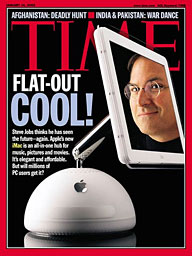
While the originaliMac seemed like a radical departure from modular beige computersin 1998, it really amounted to little more than building the computerinto the monitor and adding some color. The iMac G4, on the other hand,was a radical design departure with its computer in a hemispheric whitebase and a flat panel display practically floating in the air above it.The novel design was unexpected, and Steve Jobs even managed to get theiMac G4 on the cover of Time magazine the week it was announced.
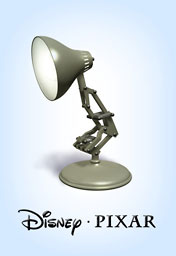
Pixar's Luxo Jr.
Today Low End Mac's staff takes a look at the iMac's design legacy,paying particular attention to the pros and cons of the G4 "Luxo Jr" design.
Alan Zisman (Zis Mac): I waslucky enough to have been invited by Apple - as one of three Canadiantech journalists - to attend the MacWorld conference where the iMac G4was announced (and lucky enough to have my airfare and hotel paid forby Apple. Those were the days!)
Personally, I found the "Luxo Jr" design a bit too quirky, though Iwas impressed by the engineering behind the floating arm supporting thedisplay. And I was even more impressed that in the time between liningup to get into the keynote and leaving the convention center in theearly afternoon, downtown San Francisco had seemingly been covered withbillboards showing off the up-to-now embargoed model.
Clearly Apple's PR was on top of its game!
Thinking back a decade, there were a couple of thingsnoteworthy about the G4 iMac - the use of a G4 processor (previouslyonly available in Apple's "high-end" pro models) and an LCD display -again, previously a rare and high-end option, while keeping the popularpricing of the iMac line. Now, it's hard to remember what a stir itmade to have an LCD display on a mid-range model.
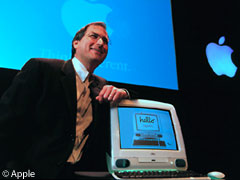
Steve Jobs introduces the iMac in 1998.
Leaman Crews (Plays Well withOthers): I do remember the original Bondi iMac being seen as quitea radical design at the time. Apple did a great job of promoting theall-in-one concept, with much fewer cables, and how simple it was toget online. This was at a time when it seemed the Apple had no idea howto promote or market their own products, so I was proud of them forselling it based on some concepts that really hit a nerve with folks inthe era of the first Internet boom. Although not as well remembered asThink Different orSwitchers, I'd have to say that Apple's campaigns revolving around theoriginal iMac were some of their most effective.
I also thought Apple did a great job of building up customerinterest in the iMac by announcing it several months ahead of itactually shipping. It was the hottest personal computer on the planetbefore anyone could even buy one. I don't recall specifics, but I doremember Apple adding some options or beefing up the specs before itactually shipped* - I'm sure the specifics could be found somewhere inthe Low End Mac archive, as it was right here at this site where I readabout the iMac, nearly daily, back in 1998 and 1999. (Improving aproduct before it hit the store shelves would be a feat Apple wouldrepeat in 2007 - the iPhone was announced with a plastic front but gotupgraded to glass by the time it was available for sale.)

Having followed Apple for a long time by 1998, I didn't think theiMac was such a radical design. To me, it was an update of the original 128K Macintosh forthe Internet era. Same concept, just newer specs and a cooler lookingcase. At the heart of both the original Mac and the first iMac was theidea that a computer should be a personable appliance. You didn't needto know your megahertz from your gigahertz, or your RAM from your harddrive space. The Mac and the iMac were compact, attractive, and didstuff for you, just like your toaster or washing machine.
It seemed like a logical thing to me and captured a retro spiritprevalent in late 1990s culture. Around the same time, Volkswagenbrought back the Beetle (also updated for a more modern age), and wewere all in anticipation of the first new Star Wars movie inover a decade-and-a-half. It was a good time to be in your 20s, withfree time and disposable income. Everyone from Apple to VW to GeorgeLucas was happy to sell me updated versions of childhood favorites.
The iMac G4's design is important in Apple history because it wasone of the few post-Bondi iMac designs that could really take yourbreath away upon first seeing it. It was a great design. At my work, webought about 100 of them in 2002, and they were real workhorses. Thelast of them were retired only last year - meaning about nine years ofperformance for some. We had a few where the neck went limp, losing itsability to hold up the LCD. But really, I don't recall having muchtrouble with any of the "flower pots", as they came to be known aroundthe office. I don't know why Apple never pursued a similar design. Itworked well, the product sold well, and it got the okay from criticstoo - a rare trifecta. Perhaps they just wanted to leave well enoughalone and let the iMac G4 take its place in Apple's long and storiedhistory.
Allison Payne (The BudgetMac): Unlike some other members of the Low End Mac staff, Iremember some of the clever marketing for the G3 iMac, but I don'tremember anything about the G4 model when it came out. If I had seen itback then, I might have found my way from the Windows wastelandsooner.
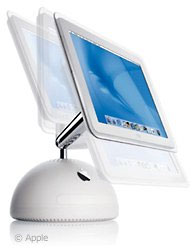
The iMac G4 "iLamp" remains my favorite Mac desktop design of alltime. I like the ergonomic, flexible neck, the gorgeous LCD, the uniqueand futuristic look of the dome. Really, there's nothing about itsdesign that I don't love. Even now I have one in service as a kitchenMac, and I just set one up for a friend as a guest computer. While Idon't think any hobbyist has managed it yet, I can't wait for someintrepid case-modder to figure out a way to wire a Mac mini in there,giving them a whole new lease on life.
Two significant drawbacks come to mind specifically for the iMac G4.The earlier models use original 802.11b AirPort cards, which arelimited both in speed and compatibility with wireless securitystandards. The RAM is only partially accessible for user upgrading (thesmaller SO-DIMM is easy enough to change out, but the internal slot ismore of a challenge), and the optical drive and hard drive are notaccessible at all unless you're very adventurous. Apple managed to crama lot of hardware inside that small dome.
The other drawbacks of the iMac G4 are largely the same as thosethat hold back any G4 in the Age of Flash and the modern Internet.Fortunately, many of the late models (1 GHz+) can run OS X 10.5 Leopard, which helps somewhatwith browser compatibility, support AirPort Extreme cards, and we'verecently discussed several ways to keep Flash running on older G4s hereat Low End Mac.
Charles Moore (several columns): I've never owned anyspecies of iMac - or any desktop computers at all since the Mac cloneera Umax SuperMac S900 that I stillhave, but which hasn't been booted up for years, and and the G4 Cube I owned for a fewmonths in 2001. One of my daughters has had several teardrop iMacs,including one of the original Bondi Blue units, but the iMac that hastempted me most was the "Luxo Jr"/"iLamp" G4 model, that I'll hereafterrefer to simply as the "Luxo."
It wasn't quite able to exert enough pull to overcome my affinity tothe freedom, flexibility, and self-containedness of laptops, but itcame closer than any other desktop Mac since the Cube, save perhaps forthe Mac mini.
Anyway, by my lights, the Luxo is the most elegantly stylish Macdesktop ever, beating out even my runner-up original compact Macintosh.I regret not having picked one up when they were still cheap andplentiful in the mid-to-late '00s. I still have two G4 upgradedPismo PowerBooks inactive service, so by that measure I could still be getting useful workout of a Luxo iMac, although the curtain is definitely lowering on G4Macs as practical production systems for even the second-tierrelatively light duty use I put my Pismos to.
The biggest limiting factor for me is browser performance. I'm stillgetting along on the Pismos with TenFourFox, OmniWeb, and whateverthe last version of Opera10.x that supported OS X 10.4Tiger was, but none are entirely satisfactory, and surfing getsslower and slower. TenFourFox is the most usable of the bunch, and ifnot for it being available, I would probably have thrown in the PPCtowel by now. As it is, I'm using my iPad more and the Pismos less forlight-duty stuff like drafting this commentary.
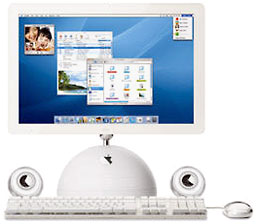
The 20" iMac G4 with speakers.
However, one of the lastLuxos came with a 1.25 GHz G4 CPU, RAM maxed-out to 2 GB, andthe high-end model's 20"1680 x 1050 display would still be a sweet and capable machine thatcan still run OS X 10.5 Leopard and deliver better performance than mywife's 1.33 GHz 17"PowerBook G4, which is still a very usable machine.
This roundtable topic got me thinking about one of the Macs I'vebeen sort of sorry I didn't buy. A bit of a flight of fancy at thisstage of the game, and portables still suit me better in practicalterms, but a Luxo Jr. iMac is something of an objet d'art, n'est cepas?
Austin Leeds (AppleEverywhere):¾ As the proud owner of a 15" 800 MHz iMac G4,yet one who hasn't actually been its primary user, I must admit thatthis iMac has been a great addition to the fleet. My parents have beenthe primary users, mostly for email and Tiger's dictionary, andproblems for them have been few and far between.
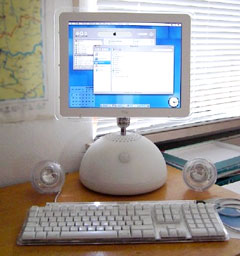
iMac with Apple Pro Speakers
However, I invariably have one use for it when I do use it: pumpingthe bass from those surprisingly powerful Apple Pro Speakers!
Leaman Crews: Nothing else to add except+1 for Apple Pro Speakers. I miss them! Throw in an iSub fromHarman Kardon, and you had an awesome setup for blasting iTunes.
Dan Knight (Mac Musings):I've never owned a G4 iMac, and I've always considered the designsomewhat weird with that white dome base, but over time, I've come tosee the brilliance of the floating display. You can raise it, lower it,or turn it so someone across the desk from you can see it. It's not asspace efficient as the later "slab" iMac design introduced with thefirst iMac G5 in mid 2004,but it's a big improvement over the footprint of the G3 iMacs and thebehemoth 17" eMac.
Honestly, I've been spoiled with dual processor G4 Power Macs, whichmakes me very impatient with older, slower Macs running OS X -especially the G3 iMacs and 'Books (all 500 MHz and slower) in mycollection. I've played with various versions of OS X, fiddled a bitwith Linux, and come to the conclusion that these are best as Mac OS8.6 and 9.2 machines. Faster processors, more memory, and faster harddrives would improve the experience, but G4 with its AltiVec velocityengine just does wonders for Mac OS X.
A last generation model (15" 1 GHz or 17" or 20" 1.25 GHz) would bea great addition to my collection, but they tend to go for collectorprices these days. I'll stick with my dual processor Power Macs untilthey die.
Jason Schrader (Maximize YourMac): I myself have never owned any iMacs. I too have leanedtowards the power and versatility of the Power Macs. My mother owns a1.25 GHz iMac G4, and it has barely been used (she doesn't even haveInternet). It's in like new condition for sure, and I asked her whatshe thought about me writing about upgrading it in my column. Shereplied, "Take it." I have always marveled at its design, especiallyits mechanical arm. It looks like nothing before it and has neverreally been rivaled in its design. I do have to say that I don't likebeing tied to a monitor, as I tend to upgrade often (I ran two foryears until I picked up a 24" model). Now I just have to go pick it upand order up some memory and maybe a hard drive (when prices go down)as there is little to upgrade on these machines.
Dan Knight: I'll weigh in with Jason on this one. Ioften use the same display for years and years longer than any of myPower Macs. Alternatively, I can just get new displays if I needsomething larger or different - no need for a whole new computer.
Dan Bashur (Apple, Tech, andGaming): Although the Luxo was first released with 700 and 800 MHzvarieties, I've always wanted a 20" Luxo with it's amazing screen realestate. However, for me the most burning memory of the Luxo's releasein January 2002 was when I purchased my Summer 2001 Graphite iMac G3 600MHz at full price for $1,299 plus tax just months earlier inSeptember 2001. I was quite happy with the purchase initially, the LuxoG4 arrived just four months later with a much sleeker design, twice thegraphics memory, and of course G4 AltiVec processing. The iMac G4 wouldhave provided me with much more long term utility than the G3 iMac (the800 MHz unit even shipped with a SuperDrive), and it only arrived a fewmonths later. To make matters worse, the iMac G3 600 MHz unit Ipurchased dropped to $999 after the release of the Luxo.
This is very typical of Apple - some models are small steps forward,while others are quantum leaps ahead. I will always remember the Luxoas the first Mac I should have purchased rather than the one I didpurchase.
Charles Moore: "First Mac I should have purchasedrather than the one I did purchase." That would have been a PowerBook 1400c instead of the 5300 I bought a month or so before the1400 was released. I did eventually own a 1400 (and still have it), butas a near fully-depreciated obsolete unit.









